Matador Network's Blog, page 141
July 26, 2024
Treehouses on Airbnb

Treehouses are no longer just a fixture of youthful fantasy. Thanks to some creative (and daring) designers, sturdy trees, and the modern convenience of Airbnb, there are a number of spots around the world where you can swap the plain jane hotel for an epic treehouse on your next trip. These are the most epic treehouses on Airbnb.
We hope you love the Airbnb treehouse rentals we recommend! Just so you know, Matador may collect a small commission from the links on this page if you decide to book a stay. Listed prices are accurate as of the time of publication.
Treehouse Canopy Room at Miami permaculture farm – Miami, Florida Photo: Airbnb
Photo: Airbnb Photo: Airbnb
Photo: Airbnb Photo: Airbnb
Photo: Airbnb Photo: AirbnbSee more photos
Photo: AirbnbSee more photosThis one bedroom, one bath treehouse is located on a permaculture farm in the heart of Miami’s Little Haiti neighborhood, offering a relaxing step away from the hecticness of the city. As a bonus, you get to enjoy fresh fruits and veggies from the farm during your stay.
Three guests, one bedroom
Price: $65 per night
 Photo: Airbnb
Photo: Airbnb Photo: Airbnb
Photo: Airbnb Photo: Airbnb
Photo: Airbnb Photo: AirbnbSee more photos
Photo: AirbnbSee more photosThis private room in a treehouse could be the ultimate getaway for your next mountain vacation. The treehouse offers the perfect view of Pleasant Bay from the side of Chuckanut Mountain. Access to the host’s home is easy for bathroom and kitchen use.
Two guests, one bedroom
Price: $255 per night
 Photo: Airbnb
Photo: Airbnb Photo: Airbnb
Photo: Airbnb Photo: Airbnb
Photo: Airbnb Photo: AirbnbSee more photos
Photo: AirbnbSee more photosThis one’s not for the budget traveler, but if you’re down to shell out for three months of luxury, the views are as rewarding as the amenities. The rustic decor is complemented by floor-to-ceiling windows, a hot tub, and easy access to both a rainforest and two Australian National Parks.
Two guests, one bedroom
Price: $24,000 per month
 Photo: Airbnb
Photo: Airbnb Photo: Airbnb
Photo: Airbnb Photo: Airbnb
Photo: Airbnb Photo: AirbnbSee more photos
Photo: AirbnbSee more photosYou may have seen this one before, for good reason — this awesome accommodation has been featured on the Today Show and Treehouse Masters. This raised lodging offers one bedroom and two additional furnished rooms and is easily accessed from downtown Atlanta.
Two guests, one bedroom
Price: $285 per night
 Photo: Airbnb
Photo: Airbnb Photo: Airbnb
Photo: Airbnb Photo: Airbnb
Photo: Airbnb Photo: AirbnbSee more photos
Photo: AirbnbSee more photosTake in the stunning island and lush jungle vistas of Bali from above the trees in this one-bedroom, one-bath treehouse. It even has an onsite pool you can take advantage of.
Two guests, one bedroom
Price: $103 per night
 Photo: Airbnb
Photo: Airbnb Photo: Airbnb
Photo: Airbnb Photo: Airbnb
Photo: Airbnb Photo: AirbnbSee more photos
Photo: AirbnbSee more photosThis treehouse sleeps five people in three beds, and comes decked out with roped bridge to make you feel like a pirate on the lookout. It’s also an ideal base for outdoor activities just outside of Montreal.
Five guests, two bedrooms
Price: $152 per night
 Photo: Airbnb
Photo: Airbnb Photo: Airbnb
Photo: Airbnb Photo: Airbnb
Photo: Airbnb Photo: AirbnbSee more photos
Photo: AirbnbSee more photosThe Crystal Peak Lookout is a cozy retreat open year-round — it even has a warm wood-fired stove perfect for chilly nights or heating up water for morning coffee. After a day of hiking or snowshoeing, unwind in the wood-fired sauna below. And yes, there’s an outhouse – no fire lookout is complete without one! You’ll have 13 wooded acres surrounding this treehouse originally built in 1959. The structure was moved to its current location in 1983 and fully remodeled in 2018. Immerse yourself in nature as you share sunsets with mountain bluebirds, gaze at starlit skies, and maybe even spot a passing moose. Explore the surrounding area, picking huckleberries in the summer or following fresh moose tracks in the winter. Access to the lookout, outhouse, and sauna is yours to enjoy, with snowmobile or Polaris Razor access available during winter months.
Two guests, one bedroom
Price: $200 per night
 Photo: Airbnb
Photo: Airbnb Photo: Airbnb
Photo: Airbnb Photo: Airbnb
Photo: Airbnb Photo: AirbnbSee more photos
Photo: AirbnbSee more photosThe Willow Treehouse is a secluded escape nestled among trees, overlooking a swimmable pond, just a 15-minute drive from Woodstock. This cozy retreat offers everything you need to unwind, from cooking and reading to simply relaxing on the couch and enjoying the view. Disconnect from the world with no WiFi or cell service and immerse yourself in nature. Perfect for couples or solo adventurers (2 adults max). Just keep in mind, the loft is accessible only by ladder — so pack light.
Two guests, one bedroom
Price: $375 per night
 Photo: Airbnb
Photo: Airbnb Photo: Airbnb
Photo: Airbnb Photo: Airbnb
Photo: Airbnb Photo: AirbnbSee more photos
Photo: AirbnbSee more photosThis romantic treehouse is nestled on an 800-acre working ranch, which means animals are never far away. It’s perfect for anniversaries, birthdays, or for a weekend away with your partner. The setting is lush and wild, especially for this part of Texas, and you’ll have a chance to take it in from the outdoor screened-in bathroom. Inside is a kitchen equipped with a small refrigerator, propane grill, gas cooktop, and Keurig coffee maker.
Two guests, one bedroom
Price: $295 per night
 Photo: Airbnb
Photo: Airbnb Photo: Airbnb
Photo: Airbnb Photo: Airbnb
Photo: Airbnb Photo: AirbnbSee more photos
Photo: AirbnbSee more photosLilla Rustica is a magical treehouse retreat built by the renowned Tree House Guys. This cabin boasts stunning views of Camels Hump State Park and a perfect blend of natural simplicity and thoughtful details. The loft’s queen bed and downstairs queen bed with panoramic windows offer unparalleled stargazing and wildlife encounters. You can hike straight from the doorstep, so it’s great for active adventurers.
You’re still conveniently located near Route 100, which puts you within a short drive of Ben & Jerry’s, breweries, ski resorts, and swimming holes. The cabin provides essential amenities like internet, a small refrigerator, luxurious linens, a propane fireplace, and fresh spring water. Although off-grid, there’s an outhouse for your business and it even comes with a view. 
Four guests, one bedroom
Price: $255 per night
This Map Shows Where to Find a Michelin-Starred Lunch in Paris For as Low as 32 Euros

Paris is the city with the highest number of Michelin-starred restaurants in the world. Research by the culinary website Chef’s Pencil shows that a meal in a Michelin-starred restaurant in the French capital costs an average of €210 ($230) per person. According to the same research, the most expensive Michelin-starred restaurant in Paris, Guy Savoy, charges €680 ($735) per person for the tasting menu. But among the 121 Parisian restaurants that have been awarded the prestigious distinction in 2024, some are surprisingly affordable.
Because very few people have $228 to spend on a single meal — let alone $735 — we looked the lists of the cheapest Michelin-starred restaurants, compiled by Michelin Guide itself and Chef’s Pencil, to map the 15 most affordable options in Paris (under €60 or $65) . That way, you can try out some very fancy food without blowing your budget.
Michelin-starred restaurants in Paris for affordable lunches (under €60 or $65)Click on each restaurant’s name to see each the lunch price and access the link to its website.
The cheapest Michelin-starred restaurant in Paris for lunch is Benoît, holder of one Michelin star and located in the fourth Arrondissement of Paris. The lunch menu starts at €32 ($35) for a starter and an entrée or an entrée and a dessert. If you opt for the bigger lunch option (starter, entrée, and dessert), it’ll cost you €42 ($45).
Of course, making a reservation early is highly recommended for the restaurants featured on this map, especially if you’re visiting this summer while the Olympic Games are taking place. 
July 25, 2024
Tested: How Kyte Is Making the Often Frustrating Car Rental Process More Seamless

Waiting in a rental car line is high on my list of things I try to avoid after a flight. This was confirmed on a recent trip to Washington when I saw hectic crowds squeezing around the construction at Seattle-Tacoma International Airport. This time around, I avoided them all with Kyte, a rental car company started in 2020 that delivers cars right to you or offers pick-ups and drop-offs at lots near select airports.
I rarely rented a car on my travels before I became a dad in late 2022, either for my frequent work trips as a travel writer and editor or for my own personal trips. I always packed light, and kept my schedule flexible to accommodate whatever public transportation had to offer (which often also meant a fair bit of walking). Traveling with a kid comes with a lot of literal baggage that’s not public transportation friendly. Another benefit? It opens the door to more easily explore rural areas around the cities I visit most.
The concept of Kyte will be familiar to anyone who has used any of the app-enabled services that have popped up over the last decade and a half: minimum human interaction (about 10 minutes with someone to check in and drop off a car, zero interaction with other people using the service); booking, verification, and alerts all handled immediately through an app; and often lower rates than the old way of doing things.
It does differ in a significant way from the Ubers and Airbnbs of the world, however. Kyte is not a peer-to-peer service that’s part of the “sharing economy.” Kyte owns all of its vehicles through a fleet provider, and professionally maintains the cars for the up to two years the company uses them.
“I previously worked at Uber and saw that people were always in search of convenience when it came to traveling,” Kyte cofounder Nikolaus Volk says in an email. “No one wants to wait in lines or be waiting for a driver. There were only these outdated methods when it came to renting a car and that always involved going to the airport or car rental storefront. There wasn’t an option to get a car for those short trips (and one that comes to your doorstep), and that’s where we started to design the model from.”
Kyte started during the pandemic, and only operates in a select set of cities. That limits use to people traveling to or using 12 major cities as a base where they can pick up or drop off their rental. More metro areas in the United States, as well as international, are set to be announced in 2025 as growth continues, Volk says. It’s important to note that currently cars are only available for use in the US. Users are responsible for the full cost of anything that happens if a vehicle is taken into Canada or Mexico.
Kyte is available in the following markets as of mid-2024:
AtlantaBostonBrooklynChicagoDenverJersey CityLos AngelesNew York CityPhiladelphiaSan FranciscoSeattleWashington, DCGetting set up with KyteIt’d be hard to argue that the days of glitchy and unusable apps are completely over. Yet we are living at a time when certain companies have taken all of the frustrations out of booking and arranging travel over an app through better tech and better design. Kyte is on a higher level than most, with a user experience on par with the ease of the award-winning United Airlines app.
I was able to submit my license, photo verification, credit card, and other information on the Kyte app even with spotty service from an Airbnb in Sitka, Alaska. The whole process, from download to booking confirmation, took about 15 minutes.
The cost of renting a car through KyteRental cars are also expensive. A NerdWallet analysis of more than 480 rental car prices in 2024 found that the record high costs from July 2021 have abated, but every month in the first half of 2024 had a higher rental car price than any time before the pandemic — an average of 35 percent more, to be exact.
By NerdWallet’s numbers, the average seven-day car rental from Seattle-Tacoma Airport in 2024 is $690.60. The price we saw when booking our trip through an online travel company that compared costs from various brands in mid-July was more than $800 for six days, and that included savings from booking the car and flight together months ahead of time. We weren’t able to guarantee a vehicle big enough for myself, my wife, our toddler and her car seat, and our nanny (not to mention all those bags). While we were told an upgrade could be made at pick-up if a larger car was available, we could only be confirmed for a Ford Mustang — a two-door car with a decent trunk, but not ideal if we wanted any sort of comfort and space, regardless of how much I wanted my daughter to experience the joys of driving with the top down.
The options on Kyte couldn’t be more different. After registering, I booked an SUV with plenty of space in about 10 minutes just three days before we arrived in Seattle. The rental itself was $497.94, with an airport fee of $122.96. SUV damage insurance added another $114, and I added optional liability insurance for $119.94 (renters can skip this if their credit card insurance is sufficient). The total of $854.84 was about the same as our prior discounted booking, but only because I was able to secure extra insurance and a guaranteed vehicle type. Both of those things weren’t yet calculated into the price we would have seen if we went forward with our previous arrangement. By contrast, Kyte’s pricing is transparent before completing a reservation.
“Kyte fundamentally takes cost out of the operating model by getting rid of branches, staff and physical real estate,” Volk says, adding that “the primary guiding factor behind Kyte is to design the experience around the consumer. Our goal is to make it convenient, accessible and reliable. This also involves full transparency about fees, costs, insurance, etc.”
There are a lot of cost variables with travel, and car rentals are no exception. I highly suggest checking the price on Kyte before committing to any one service, as in my experience there was greater price transparency, more guarantees, and an overall comparable or lower rate.
Picking up and dropping off a Kyte rental car
Photo: Nickolaus Hines
The biggest differentiator is the straight-to-you delivery model that Kyte started with. A representative, called a Kyte Surfer, will drop off or pick up the vehicle in a 10-minute window of the designated time set when booking. There’s a $10 late fee outside of the grace period up to 30 minutes, or a $25 rescheduling fee outside of that time frame to compensate the Surfer for their time.
Kyte accounts for the sometimes unpredictable nature of travel with an easy method to update your times through the app up to two hours before the originally scheduled time for free. You can easily extend your rental through the app or shorten it for free more than 48 hours of the original drop-off (you’ll get a Kyte credit for the unused days if it’s less than 48 hours).
Both of the Surfers I interacted with were professional, timely, and seemed just as interested in making small talk as I was (meaning zero interest). Avoiding the back-and-forth upselling tactics I’ve experienced at every traditional car rental pick-up desk is reason enough to choose the service, in my opinion.
Kyte has expanded into select pick-up and drop-off locations since its launch — a crucial addition for people arriving at the airport and needing a vehicle immediately. While that makes it more similar to a standard car rental, there are still some clear advantages. Kyte’s locations aren’t in the hustle and bustle of the airport car rental center, so no waiting in line in close proximity to a bunch of people very tired of being crammed into close quarters after their flight. There’s also a bigger two-hour window for pick-ups and drop-offs.

Photo: Nickolaus Hines
That does mean some walking, however. At the Seattle airport, the pick up spot is at a lot that’s about a 15-minute walk from the terminals. The app provides clear walking instructions and helpful pictures to get there, but I did have to leave my bags with my wife at the terminal to avoid carrying our stuff, our toddler, and the many things that come with traveling with a toddler through the 90-degree summer heat. On the return, it meant dropping them off with our stuff before returning the car and meeting back up in the airport.
“Admittedly, Kyte is only carefully rolling out its service to airport locations in the country for exactly those reasons,” Volk explains. “We are doing a lot of diligence on customer experience, locations, etc. before launching new airports.”
The only other notable disadvantage for travelers is the need for a hand-off with a Surfer. While convenient during normal business hours, there’s no option for people taking a red-eye and no way to leave the car somewhere after hours. A little prior planning gets around that issue, though, as users can arrange for a car hand-off at their accommodations the day before they leave — even if they used a designated airport location for the pick-up.
Comparing Kyte to other rental car alternatives
Photo: Kyte
I’ve experimented with other car rentals outside of the traditional companies with mixed results. Turo, which takes the sharing economy concept of Airbnb and applies it to cars, has been one go-to, but has it’s downsides.
For one, renters are using someone’s daily car, so there’s always a more lived-in feel — and an owner who has very specific thoughts about how their vehicle is used. When my wife booked a Turo for a bachelorette party, the owner informed her that he had an Apple AirTag in the car for his own peace of mind and to be able to quickly find the car if there were any issues. Aside from the creepiness factor, that created an obvious safety issue for a group of women who were then forced to share their location on every drive with an unknown man, as well as alerting the owner to their Airbnb’s address and when they were likely there. There’s no guarantee that a Turo renter will get that same disclosure, and the possibility of the same thing happening again without being told ahead of time has always been in the back of our minds.
Some things with Kyte are standard for the rental car industry. There’s a mileage limit of 300 miles per day, calculated as the total number of days times 300. It’s 45 cents per mile after that, or you can opt for unlimited mileage for $15 per day during booking on the app or ahead of your trip with the help of a customer service agent. You can fill the tank back up yourself or pay for a small refueling fee similar to other car rental options. The minimum age for a driver is 21 (it’s free to add another driver) in all states but New York, where it’s 18, and there’s the typical young renter fee for drivers under 25.
The biggest advantage I found was the reliability of what you’re going to get. There’s no ambiguity or random upgrades or downgrades: what you book is what you receive. Full-size SUVs have seven seats, all economy cars on Kyte are four-door, and AWD options handle inclement weather. The luxury option is an Audi Q3, and for those who want to go electric there’s a standard option (Chevrolet Bolt) or premium (Tesla Model 3). The car models in each of Kyte’s eight vehicle classes are clearly laid out on the website.
Then there’s the customer support. I’ve spent hours on hold with car rental companies only to be hung up on. Thankfully, I didn’t have any issues when using Kyte. If I did, the response would be near immediate.
“We have an incredible Customer experience and customer support team who can help in any situation,” Volk says. “You can reach them via the in-app chat very quickly and they can also hop on the phone if there are issues. Our response times are usually in less than 30 seconds so you don’t have to worry about being stuck on a line for hours with other players. We want our customers to feel taken care of at each point in time.” 
Taking a National Park Trip? Here’s Why You Should Stay Inside for at Least One Night.

A month or so ago, I took a quick trip to meet my family for a few days in Yellowstone National Park. It’s one of the most popular parks in the national park system, and known for very long lines at the park’s few entrances on busy weekends. We rented a cabin in West Yellowstone, the busiest and most crowded gateway town just a few miles from the West Entrance.
Because we were there over a weekend, I worried that we were going to spend hours sitting in lines on Saturday morning, too. I knew also that I wanted to treat my parents to a wildlife experience to give them the chance to see grizzlies in the wild, but getting through the traffic to be in the park early enough to swing that seemed almost impossible.

The lobby of Yellowstone’s historic Lake Lodge. Photo: Suzie Dundas
That’s when we came up with a not-so-original, but very helpful idea: We spent one night inside the park, staying in national park lodging. We booked two cabins at the Yellowstone Lake Lodge, allowing us to spend the evening watching elk on the shore of Lake Yellowstone and relaxing in oversized rocking chairs, rather than commuting out of the park. And since our morning wildlife tour meeting point was less than a mile from the lodge, we didn’t have to wake up in the middle of the night to meet our guide.
Staying the park was a unique experience, and it occurred to me while watching the sunset that staying in national park lodging for at least one night of a national park vacation offers far more benefits than just easy access to morning wildlife. There are a plethora of benefits of spending a night or two within the park boundaries.
Yes, you’ll improve your chances of spotting wildlife
Yellowstone’s grizzlies are most active at dawn and dusk. Photo: Suzie Dundas
Early risers often reap the greatest rewards when exploring national parks as wildlife activity tends to peak in the morning hours. That’s especially true in the summer, the main season when people visit most national parks, as animals tend to be less active during the hottest part of the day. It’s also much easier to spot wildlife when parks aren’t crowded and there are fewer cars and voices to scare them away.
If you’re keen on photographing wildlife, you’ll find that most wildlife photography tours offered through national parks start very early. Yellowstone’s “Picture Perfect Photo Safari” starts at 5:45 AM, and Glacier Photo Guide‘s sunrise photo class at Lake McDonald starts at 5:30 AM. Staying inside the park makes it much easier to make those early morning times, rather than waking up hours before that to account for time spent driving into the park.
You’ll have smaller crowds in the morning and evening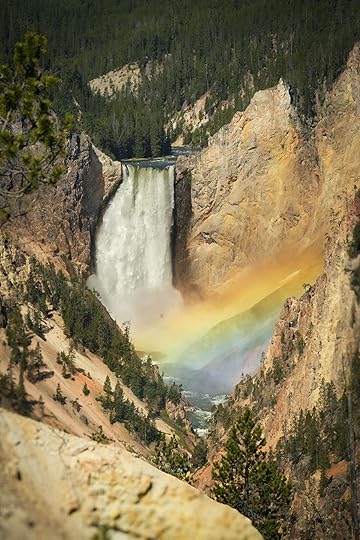
The rainbow at Grand Canyon of the Yellowstone happens only once a day — in the morning. Photo: Suzie Dundas
Maybe the most obvious reason to spend a night inside the national park is to have the park all to yourself before the days’ crowds arrive. Consider spending a Friday night in the park if you’re able, since lines to enter most parks tend to be longest on Saturday mornings. Instead of sitting in an hours-long line to enter the park, you’ll be able to be the first one on the trails, get to the best viewpoints without throngs of travelers, and find parking at popular parking lots hours before the park reaches peak capacity.
You don’t need a park reservation
Photo: NPS/Public Domain
Many national parks now require reservations for day visitors, including Yosemite National Park in California, Rocky Mountain National Park in Colorado, and Mt. Rainier National Park in Washington. Depending on the park, you’ll probably need a reservation to enter any time between 5 or 6 AM, and 4 or 5 PM. Most reservations need to be made in advance online, and when they’re done, they’re gone.
Fortunately, if you have a reservation for lodging inside a national park, be it a hotel, cabin, or campsite, you don’t need a separate park reservation. Sure, booking a hotel is likely to be more expensive than a park reservation (which is usually free, or somewhere around $5), but if you’re on the fence about booking a room, just know it’ll at least take away the hassle of trying to find a second park entry reservations.
You’ll support park conservation
Spending money at national park lodging helps parks generate income for conservation programs. Photo: NPS/Public Domain
It’s great if you throw a few bucks in the park donation box inside the visitor center. But if you stay within the park, a percentage of your spend goes directly to park conservation and environmental protection efforts. A portion of lodging revenues often supports park operations, maintenance, and preservation initiatives. Lodging managed directly by the National Park Service (such as campgrounds and cabins) usually gives the largest percentage back to the park system. But hotels managed by third-party operators like Pursuit’s Denali Backcountry Lodge or Delaware North’s Yavapai Lodge in Grand Canyon NP still bring money back to the park coffers.
You can experience classic National Park architecture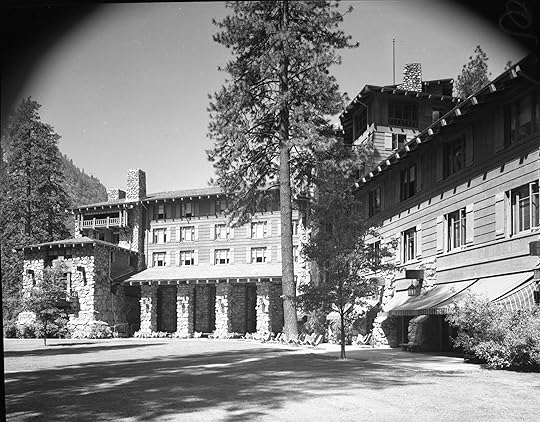
Staying in classic national park lodging can be a way to connect with the past and feel what it was like to explore the parks a century ago, like at the Ahwahnee in Yosemite National Park. Photo: NPS/Public Domain
Classic national park architecture, called “parkitecture,” is a distinctive architectural style found in many national parks. It’s a hallmark of America’s natural heritage and is sometimes so complex and expensive that it could never be built today. And some of the most iconic examples of parkitecture are found in the lodges and hotels that emerged in the early 20th century.
Yellowstone National Park’s Old Faithful Inn, with its towering log beams and rustic charm, is perhaps the most famous, but Glacier National Park boasts a collection of stunning lodges, including Lake McDonald Lodge and Many Glacier Hotel. Yosemite National Park’s Ahwahnee Hotel, with its granite facade and grand interior, is another masterpiece of parkitecture.
Most classic national park hotels offer free daily tours, including the Old Faithful Inn and the Prince of Wales Hotel in Canada’s Waterton Lakes National Park. They’re a fascinating way to learn about the history of national parks like Yellowstone, whether you’re a fan of architecture or not.
It reduces your carbon footprint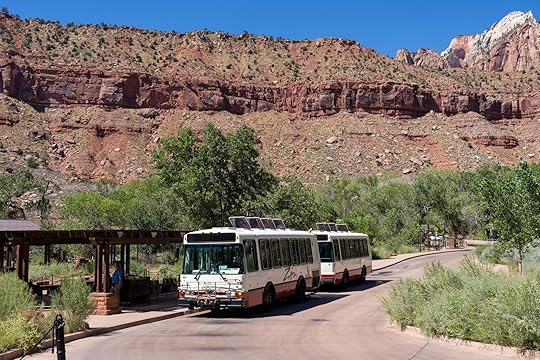
If you stay in national park lodging, your hotel or campground will almost certainly be a stop on the shuttle system. Photo: NPS/Public Domain
If you love national parks, you probably also love the whole “let’s not destroy the planet” concept. Unfortunately, flying to remote destinations and driving in and out of parks every single day releases a lot of CO2 into the atmosphere. Staying within the national park and skipping the commute to and from the park for even one day can help reduce how much carbon is being released into sensitive environments as a result of your trip.
Plus, national park hotels are almost always stops on the park shuttle systems (for parks that have them), meaning you can leave the car parked and take public transportation for the day. Not only does using the park shuttle greatly reduce your carbon footprint, but it also spares you from having to deal with driving and finding parking at busy trailheads.
You can enjoy the parks late at night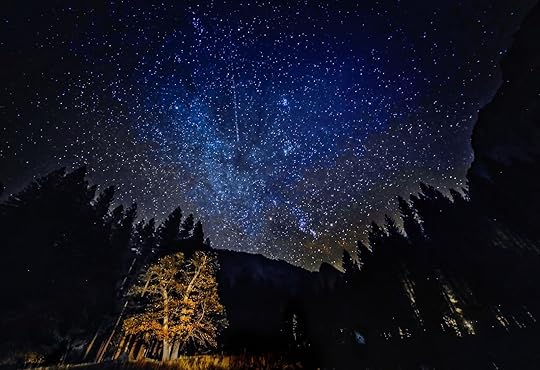
Stargazing in the Yosemite Valley late at night. Photo: Suzie Dundas
Finally, spending the night in a park isn’t just so you can wake up early — it’s so you can stay up late. Many national parks have excellent restaurants (including Yellowstone, for the record), and if you want to try a few local beers or glasses of wine with dinner, you’ll want to be within walking or park shuttle distance of wherever you’re sleeping.
Boozing aside, staying within the park means you’ll have access to the park for catching a sunset, stargazing all night, or attending evening ranger talks without worrying about your drive home. 
Salt Lake City’s Best Hotel Combines Classic Elegance, Contemporary Cool

There are a lot of nice hotels. Places that are clean, comfortable, and maybe even trendy enough to have a hip bar or a coworking space onsite. Far rarer is a great hotel. One where you can feel both opulence and a separation from the property’s surroundings, but that still feels approachable even after arriving defiled from a hectic travel day. One that’s common areas bustle with beguility but whose guest floors revere a vibe both austere and muffled. The Grand America Hotel, in downtown Salt Lake City, is a great hotel.
The Grand America Hotel’s ornate lobby is characterized by oversized Italian glass chandeliers and elegant, French-inspired decor and furniture. This is iconic of the Grand America brand, which also operates several Little America Hotels across the southwest as well as Snowbasin and Sun Valley ski areas. Here, the lobby, rooms, and amenities are lined with historic works of art, enough so that the hotel’s management finds it appropriate to offer an in-house art tour. The property feels almost colonial. Iits offerings, however, are strictly modern – a high-end spa, indoor and outdoor pools, and an elevated Brasserie whose primary purpose seems to be to defy musty stereotypes of its host city.
I recently visited Salt Lake City with my wife for a romantic getaway (code for “we had Blink-182 tickets,” the most romantic activity a couple can pursue), and chose the Grand, with rooms from $264, for its amenities and downtown location near the venue. We walked out the door standing straighter than when we walked in, having slept, dined, and spa’d ourselves into a mode of relaxation neither of us has known since before we became parents.
We hope you love the Grand America Hotel! Just so you know, Matador may collect a small commission from the links on this page if you decide to book a stay. Listed prices are accurate as of the time of publication.
Rooms at the Grand America Hotel Plenty of space to lounge. Photo: Tim Wenger
Plenty of space to lounge. Photo: Tim Wenger We slept in, which is a major accomplishment for the parents of a toddler. Photo: Tim Wenger
We slept in, which is a major accomplishment for the parents of a toddler. Photo: Tim WengerThe Grand America Hotel has 775 guest rooms across 24 floors. We stayed in an Executive Suite with a king bed. When writing about hotels, I typically begin discussion of my room based on first impression. The Grand, however, warrants a different approach. I’ll start at 7 AM the morning after our first night, because it was about that time when I realized why this hotel is special. In most hotels, even higher-end ones, this is about the time when room doors begin being opened and slammed shut, followed by the sound of boot-clad feet stomping down the hall. Giggling children’s voices penetrate the walls, and the building buzzes with the sound of dozens of shower heads simultaneously raining down onto the manes of dreary-eyed guests.
All of this was very likely happening inside the Grand America at that moment. Thing is, I’d never have known, because I couldn’t hear any of it. Our room, halfway down a long hallway on the second floor and overlooking the pool, was the quietest hotel room I have ever stayed in. That’s saying a lot from a travel editor who spends upwards of 60 nights a year in hotels. It was SO quiet in our room that my wife, who typically wakes by 6:30 AM each morning, slept until nearly 10 AM.
By the time she’d awoken I’d already pushed through two hours of work on my laptop, visited the cafe in the lobby for coffee, and ordered breakfast to be delivered to the room. We have a toddler and I haven’t had a moment to twiddle my thumbs since she was born, but I nearly did so on this day, lounging on the couch in our suite, wondering whether I should open the blackout curtains and rouse my partner or let her sulk in a rare moment of true rest.
The bed was plush and soft. The pillows and sheets were crisp. The bathroom featured two vanities and a jacuzzi tub, in addition to the shower. I noted above the work that I did that morning. The living room area had a large wooden desk with ample lighting, in addition to a couch and two chairs. I had options of where to post up and push through emails. Another thing that stood out to me about the room was the Wi-Fi. In most hotels, whether or not the Wi-Fi works well, I must log in or at least select the network each time I wish to connect. Not the case at the Grand America. After one login, my laptop and phone connected automatically throughout our stay, which included multiple comings and goings from the property. The signal was strong enough to stream video and upload with alacrity. I felt far more productive than I typically do while holed away in a high-end hotel.
Dining at the Grand America Hotel Salmon with spring pea risotto and Crème Fraiche Vinaigrette. Omega-3s! Photo: Tim Wenger
Salmon with spring pea risotto and Crème Fraiche Vinaigrette. Omega-3s! Photo: Tim Wenger Never has a cup of soup been so refreshing on a hot day. Photo: Tim Wenger
Never has a cup of soup been so refreshing on a hot day. Photo: Tim WengerBefore heading out to the concert our first night in town, we dined at the Grand’s Laurel Brasserie & Bar. The vibe is hip and modern, a nice contrast to the classic elegance on display elsewhere onsite. Bright greens and whites played fancifully throughout the dining room and bar area. Local craft beer flowed like it does with plentitude in today’s Salt Lake City, freer of the Mormon church’s once prevalent dominance over local liquor laws. I had a Cutthroat Amber from Uinta Brewing, and a glass of Argentinian red with dinner.
The menu and service are European rooted but American in presentation. We had drinks on the table within a few minutes of sitting, and a round of soups a few minutes after that. The roasted tomato soup was refreshing, and the Maple Glazed Pan-Seared Scottish Salmon was perfectly cooked and wasn’t too much before a night out. As is standard in mountain-adjacent cities like Salt Lake, my wife and I were appropriately dressed for a nice dinner in “elevated casual” attire. I wore a button-down collared shirt and shorts, she wore jeans and a button-down shirt. We were in and out and on our way to the show in about an hour, though tables around us lingered longer over drinks and dessert.
To access the restaurant we passed through Bonne Vie, the French patisserie and coffeehouse from which I snatched our coffees each morning during our stay. This bright spot offers limited seating with excellent coffee and snacks. I spent an hour or so working at a table one morning, watching people come and go, and the Wi-Fi was equally strong as it was in the room. The hotel also has a lobby bar and cafe that makes a great space for group get -togethers or a nightcap after returning following an evening out.
The breakfast I ordered to the room after our first night was delivered in about 30 minutes and prepared quite well. We each had eggs, toast, and a protein, with coffee of course. It was standard and delicious, not over-the-top or unique but just what we needed for a morning meal before heading out.
Our experience at The Grand Spa It's easy to unwind in a setting like this. Photo courtesy Grand America Hotel
It's easy to unwind in a setting like this. Photo courtesy Grand America Hotel Look at all those showerheads. Photo courtesy Grand America Hotel
Look at all those showerheads. Photo courtesy Grand America HotelAs noted above, we have a small child at home. With busy careers and our home life spent chasing around a near-three-year-old, self-care isn’t often on the docket for us these days. This trip was to be different, and we visited The Grand Spa for a Couples Massage, $430, after our penultimate night in the hotel to ensure this. I don’t often indulge in spa services, not for disdain but simply because I just never seem to prioritize this type of stuff, to my own detriment I’m sure.
The couple’s massage experience began with a shower featuring heads spraying from every direction, including underneath. The exact number I believe was 17, though I was too focused on letting loose to confirm. This was followed by the massage itself, a 50-minute practice with us each on separate massage beds positioned next to each other. We were paired with opposite-gender masseuses, though guests can request a preference if they prefer. The experience left us both feeling quite relaxed. After the massage I relaxed in the steam room then enjoyed a cup of tea in the lounge, and left the spa feeling better than I have in years. I told my wife as we departed that I now plan to get a massage at least every few months. I don’t think she believed me, but if that proclamation stands as a testament to The Grand Spa experience, from a vagabond journo and former punk rocker, it’s a high mark indeed. 
Southwest Will Stop Open Seating. Here’s What the New Model Could Be Like.

Southwest Airlines uses quite a bit of marketing branded around a heart logo, because it claims it “LUV’s” its customers. Its stock ticker is “LUV.” And it’s slogan is also very customer-friendly: “Low fares. Nothing to hide. That’s TransFarency!”
But the airline just announced an upcoming change that may make those fares not quite as low: the end of open seating.
Southwest has used the open seating concept for decades, in which guests are assigned a boarding number based on how quickly they check-in for the flight. A1 gets to board first and gets first pick of seats, while passengers with a boarding number around C30 and worse are pretty much guaranteed to be left with middle seats. Southwest also introduced early boarding in 2022, available for a fee starting at $30, that would guarantee you a number in the A1-A30 range. Supposedly, the open seating model speed up the boarding process.

Southwest’s open seating model assigns a boarding group based on how quickly you check in. Photo: Suzie Dundas
But today, Southwest Airlines announced the concept of open seating will be no more, though it didn’t say when the new model will go into effect.
According to the news release from the airline, “The research is clear and indicates that 80% of Southwest customers, and 86% of potential customers, prefer an assigned seat.” It also announced it will creating premium seating with more leg room, as well as more comfortable seats across all fare classes. The airline will also introduce a few new red-eye routes starting in February 2025, including Las Vegas to Baltimore or Orlando; Los Angeles to Baltimore or Nashville; and Phoenix to Baltimore.
Southwest Airlines claims the change is to reflect customer preferences, citing research that shows when customers choose an airline other than Southwest, it’s usually because they want an assigned seat. Realistically, however, it’s likely to also be a profit driver for the airline, which is flying with fewer planes in 2024 and 2025 due to delivery delays from Boeing.
If it follows the model of other US airlines, it will likely charge passengers to select a seat.
Rates for seat selection on a United Airlines basic economy fare start at $15 per segment, while American Airlines starts at $10 to choose a seat with its basic fare. Alaska Airlines charges $35 or more to select a seat with a basic saver fare (as the only seat you can pick is one with extra leg room), and flyers in Delta’s most basic class of service will need to pay at least $15 to choose a seat in advance. Budget and low-cost airlines charge even more; Frontier starts at $17 but can go up to $60 or more, and Spirit Airlines starts around $20.
Southwest said it plans to share more details in September, so flyers traveling in August shouldn’t notice any changes to their flight experience. 
How to Vacation in Vermont as a Black Traveler

As a Black traveler, what I look for in a destination is whatever makes it unique — in Vermont’s case, draws like renowned fall foliage, maple syrup, and skiing. But I also seek out places that are welcoming to travelers of color through diversity and representation. Black and other minority groups make up a small fraction of Vermont’s population, which, frankly, made me apprehensive to visit. But what I found when I made the trip was a beautiful, neighborly state filled with a host of Black-owned businesses to support along the way.
Vermont is also a year-round destination for adventure seekers, tranquil retreaters, food lovers, and multigenerational visitors. Here’s how to experience it all as a Black traveler.
Calling all “main streets”
Photo: Vermont Tourism
While it’s not always named Main Street, most towns have at least one central thoroughfare that’s brimming with boutiques, coffee shops, bookstores, galleries, and mom-and-pop eateries. Often, historic downtowns are designated areas that nod to the past even as youthful entrepreneurs bring new possibilities. Cities and towns across Vermont present some of the most charming examples of this quintessential “main street.”
A great place to start exploring Vermont is its oldest city, Bennington , which is also home to the state’s tallest statue, the Bennington Battle Monument. History buffs may enjoy a self-guided tour through the area to learn about Vermont’s role in the Revolutionary War. For a more lively scene, there’s no shortage of entertainment as the downtown area hosts live music and food festivals during the summer, bringing people of all ages together.
Spanning several blocks in downtown Burlington is the Church Street Marketplace. It has an inviting hometown feel year-round, but my mid-October visit was something special — think turning leaves, warm cider, and artisans peddling everything from cheese and desserts to crafts. On the other side of the state, St. Johnsbury is brimming with small-town hospitality. Grab a chocolate sourdough croissant from Boule Bakery to fuel your day, then head to Railroad Street and Eastern Avenue for a little thrift shopping.
Montpelier is a hub of creativity. Enjoy rave-worthy performances — from musicals to poetry slams to show tunes — at the Lost Nation Theater. After, head to Caledonia Spirits, a distillery that also crafts artful cocktails while prioritizing sustainability, from its water recovery system and composting practices to its fully carbon-free (and majority renewable) energy. Creating space for bees to thrive (a whopping 23 acres to date) is central to the Caledonia Spirits mission, not to mention its distilling ethos — just look at its Bar Hill Vodka, which is made from 100 percent premium raw and sustainably sourced honey. If ghostly spirits are more your thing, swing by Green Mount Cemetery — legend has it that Black Agnes will haunt anyone who sits in her lap.
Across the state, historic downtowns are a hallmark of Vermont. Each has its own personality and plenty to do, from antiquing, to picnicking in public parks, to ambling past beautiful brick buildings. But there’s at least one thing they all have in common: an abundance of charm.
Heading outside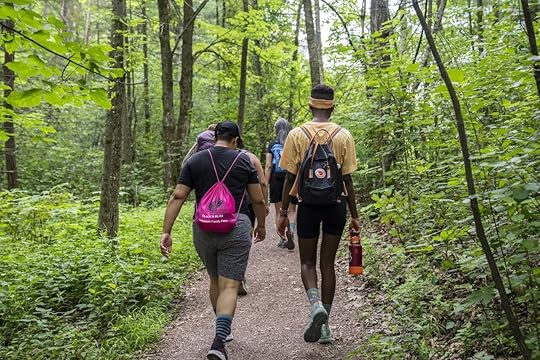
Photo: Vermont Tourism
Instead of taking it all in from a car, there are many ways to get up-close and personal with Vermont’s rolling hills, mountain peaks, and glistening lakes. It may be a small state in area, but its outdoor recreation numbers are big: 55 state parks, 800 lakes and ponds, and 1,400-plus miles of mountain bike trails, to name a few.
Vermont also plays host to the longest rail trail in New England, spanning an impressive 93 miles and five different counties. Rent an e-bike from Lamoille Valley Bike Tours to pedal one or more sections of the Lamoille Valley Rail Trail to pass through beautiful downtowns and their scenic surroundings.
However you prefer to appreciate nature — hiking, biking, paddleboarding, rock climbing, even disc golf — all methods of exploring come with breathtaking views. One of my favorite outdoor spaces is Smugglers Notch State Park, a one-time illegal trading post and route used by freedom seekers moving north to Canada. There, you can enjoy trails, explore caves, and camp. More adventurous folks can try their hand at bouldering or ice climbing.
If you’re looking for opportunities to get outside, a number of affinity groups to help to immerse BIPOC residents and travelers in Vermont’s outdoor scene through hosted events, guided programs, and meetups. Seek them out as you plan your trip, or keep an eye out once you’re here.
Fun (and sweets) for the whole family
Photo: Morse Farm Maple Sugarworks
It wouldn’t be a true Vermont trip if you didn’t get your fill of maple syrup, cheese, and creemees. These local specialties also create opportunities for fun family outings, from touring farms to sampling all of the treats your little (and big) hearts desire.
To start, Vermonters take maple seriously. More than just syrup for a short stack, maple is used to make both savory and sweet treats, ranging pickles and maple-glazed chicken to donuts and creemees, a local favorite that’s similar to soft serve. See how maple is sourced at a sugar house like Montepelier’s Morse Farm Maple Sugarworks. Visits start with a video on sugar-making, and then you can walk the “maple trail” and swing by the gift shop for maple-flavored goodies (or Cabot cheese if you’re craving a savory local treat).
Speaking of sweet treats, nothing says Vermont ice cream like Ben & Jerry’s. While there are several locations, only the original factory in Waterbury hosts tours. You’ll see how the ice cream is made, taste some, and walk through the “graveyard” of retired flavors.
For families with younger children, a trip to the Billings Farm and Museum in Woodstock promises an afternoon of fun. It’s a living history museum, which means you’ll get a glimpse of what farm life was like in the late 1800s, and the kiddos will love “meeting” the farm animals. If you’re looking for an action-packed day indoors, head to the Pump House at Jay Peak, the state’s only indoor waterpark. Kids of all ages will enjoy splash zones, a surf simulator, tube lounging down the lazy river, and water slides.
Eating your way around the world
Photo: Isora Lithgow/Thingz From Yaad
Food is one of the best ways to experience a destination because it allows us to explore a culture. BIPOC chefs throughout Vermont combine local resources with recipes from their homelands to take you on unbelievable culinary journeys around the globe.
Find a taste of Jamaica in Colchester at Thingz From Yaad. Shaneall, the owner and chef, brings authentic Caribbean flavors to Vermont with classic and reimagined dishes such as curried goat, jerk chicken, ackee and saltfish, and coconut curried chickpea. In nearby Essex Junction, couple Jessica and Joel repurposed a shed to open Mexi-Cuban Cravings, dedicated to the traditional foodways of their heritages. You can find dishes like congri, bola, Cuban sandwiches, and arroz con pollo. And just two miles away, some of the best Thai food in the state is at Sukho Thai — menu favorites include dim sum, moo ping, and krapow (holy basil) duck.
At Yalla in Brattleboro, owner Zohar Arama invites passersby to delight in dishes like falafel, phool (fave bean stew), and sfenj (Moroccan donuts) that are popular in his native Israel. Yalla translates to “come on” — a common Arabic slang word that also evidences Arama’s eagerness to spread love through food.
May and Wes Stannard made history when they opened Moonwink Cafe in Manchester Center in 2018 by bringing authentic Burmese cuisine to Vermont. The restaurant’s reputation remains strong, thanks to a delicious fermented tea leaf salad and a variety of curry and noodle dishes that keep diners coming back.
Five o’clock somewhere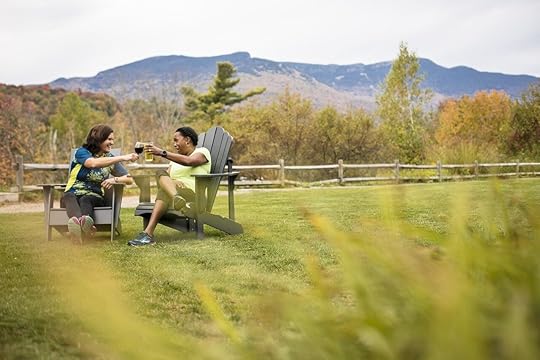
Photo: Vermont Tourism
Vermont hosts a variety of great Black-, minority-, and woman-owned wineries, breweries, and taprooms. Learn about the rich Vermont soil and crops that help produce award-winning beverages while tasting them firsthand.
If you find yourself near St. Johnsbury, don’t skip the small but mighty brewery and taproom at Whirligig Brewing & Bistro. No need to eat before you arrive — they have a selection of smoked meats and bar food that’s anything but typical to enjoy alongside your ale or lager. But one of the best things about Whirligig is its events, such as the Poetry Potluck Open Mic where attendees bring a dish and try their hand at sharing a poem.
Burlington is home to quite a few breweries of its own, not to mention a robust restaurant scene for a pre- or post-drink meal. Can’t decide which breweries to try? Organize a BrewHop Tour through Best in VT Tours & Charters to visit multiple drinkeries by party bus, or get to know the city first on a Burlington Trolley Tour — both companies are BIPOC-owned.
If you’re craving a glass of red or white instead, head to Wilder Wines in downtown Burlington, which offers natural and sustainable wines through local partnerships and ingredients. Kalche Wine Cooperative in Fletcher is another establishment to have on your radar. Created to improve outdated and inhumane production practices, Kalche is reclaiming what it means to be a purveyor of wine as a producer, tastemaker, and consumer.
Lessons in Black history
Historic Robinson Home. Photo: Rokeby Museum
As a Black traveler, I’m always curious to see how Black history is taught, preserved, and honored in a destination. Vermont makes it easy on the African American Heritage Trail. A statewide collection of sites and exhibits, the trail illuminates the lives of Black Vermonters, honoring their monumental contributions to the country.
One important stop is the Rokeby Museum in Ferrisburgh, where you’ll find an exhibit called Seeking Freedom: The Underground Railroad and the Legacy of an Abolitionist Family running throughout 2024. The exhibit talks about the history of enslavement in the US and Vermont, shares the journeys of freedom seekers on the Underground Railroad, and tells the story of the Robinson family, who went from enslavers to abolitionists.
If you’re traveling to Middlebury, read up on Alexander Lucius Twilight first. Graduating from Middlebury College in 1823, he was the first Black man to earn a bachelor’s degree from an American institution and Vermont’s first Black legislator. To do a deep dive on Twilight in person, his life is chronicled at the Old Stone House Museum in Brownington. Find even more cultural and historical stops using the African American Heritage Trail guide.
If the mark of a destination worth visiting is that you leave daydreaming about a return trip, Vermont certainly fits the bill. As a Black traveler, I found welcoming and progressive attitudes everywhere I went. Because of that, it’s a place I’d happily travel to again — and you should, too. 
July 24, 2024
Every Plane Commonly Used for Long-Haul Flights and What Each Is Known For
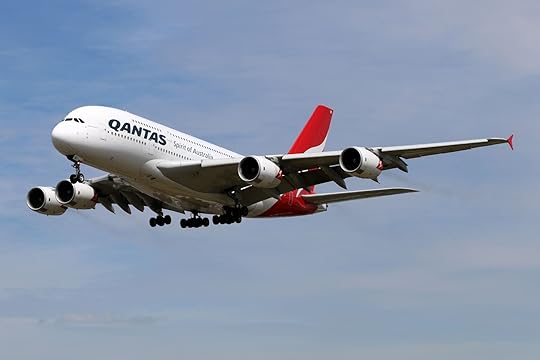
A “long-haul” is, generally, any flight lasting longer than six hours. In most cases, this means you’re flying internationally, and will be served at least one meal while on board. Considering these and other factors like fuel, staffing, international regulations, and of course, the plane itself, long-haul flights are quite expensive for airlines to operate – and only certain models of commercial airplanes are up to the task of hauling 200 or more passengers, crew, luggage, and cargo. Your experience on these long flights will vary based on the type of plane you’re on, which is likely to be one of the following.
What to consider when booking a long-haul flight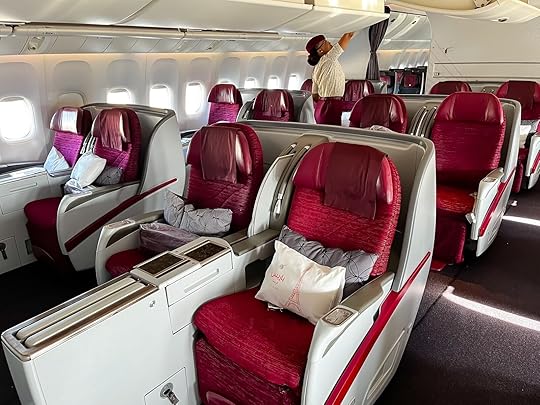
Photo: Minh K Tran/Shutterstock
Given that you’re going to be on the plane for at least six hours, you might as well be comfortable. The first aspect to this is plane size, though you’ll also want to consider seat configuration and legroom. Also, how much aisle space there is. Wide-body planes often offer more space and amenities. Seat pitch, width, and recline are key for comfort — you can typically find these specs by identifying the type of plane listed in the flight listing and then looking that plane up via the airline’s website. In-flight entertainment, Wi-Fi, and power outlets enhance the journey, and they’re all but a given on long-hauls.
A breakdown of how many passengers you’ll be sharing the skies withLong-haul flights are generally on larger planes with higher fuel capacity, and to make the flights work from a financial perspective, airlines need to fill these big planes up. Here’s how many passengers you can expect to share your next long flight with.
Smaller wide-body aircraft (like the Boeing 767): Generally between 200 and 300 passengers.Larger wide-body aircraft (like the Boeing 777 or Airbus A350): Generally between 300 and 400 passengers.Very large aircraft (like the Airbus A380): Can carry upwards of 500 passengers.What types of planes are used on long-haul flights?Boeing and Airbus, the two major producers of commercial aircraft, each offer multiple models that airlines can use for long-haul flights. Let’s start with Boeing.
Boeing 747 – the original ‘Queen of the Skies’
Photo: Miguel Lagoa/Shutterstock
The Boeing 747 debuted in 1969 as the “Queen of the Skies,” the most comfortable plane for long-haul flights at the time. It was the first wide-body “jumbo jet,” though it’s on its way out at the end of 2024, with just a few airlines still flying it. It was known for its upper deck, often used as a lounge or for passengers to have more space. Its typical range allowed for 8 to 12 hours without refueling, making it ideal for transcontinental and intercontinental routes, though it was not fuel efficient at all by the standards of today’s aircraft.
Boeing 777
Photo: Miguel Lagoa/Shutterstock
The 777 is designed for ultra-long-haul flights, those that require flying 10 to 16 hours without refueling. Because it can cross an ocean no problem, the plane is ideal for connecting distant continents and is generally operated for flights between North America, Europe, Asia, and Australia. The Boeing 777 is built with a twin-engine design offers improved fuel efficiency compared to older quad-engine models, resulting in lower operating costs for airlines. This will likely keep the plane in service for years to come. It’s also renowned for its reliability and excellent safety record – notable given the troubles at Boeing in recent years. The 777 is a preferred choice among international airlines of every major alliance.
The 777 is among the most comfortable planes for sleeping in the arrangements that most airlines use, especially in business and first-class cabins. It generally has wide aisles and seats designed for long-hauls, as well as plenty of space for cabin crew to rest and go about their business without intruding on flyers who want some peace and quiet.
Boeing 787 Dreamliner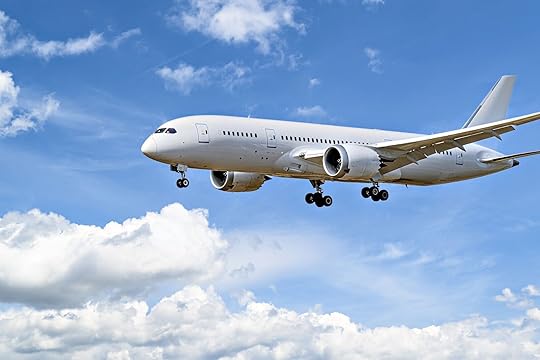
Photo: Toni. M/Shutterstock
Larger windows. Extra humidity pumped in. Wide aisles and actual room to stretch. These are the defining characteristics of the Boeing 787 Dreamliner, the torch carrier for modern ultra-long-haul efficiency. No large airplane has better air circulation, and the seating and cabin arrangements utilized by the major airlines flying the dreamliner are put in place knowing that flyers will spend a significant amount of their airtime sleeping (or at least trying to sleep).
Its innovative composite construction results in superior fuel efficiency, making it a more cost-effective option for airlines. This is good for flyers, as it should help to keep costs down even as airlines search for any semblance of “eco-friendliness.” The planes can carry between 210 and 330 passengers depending on length (three sizes are available – the 787-8, -9, and -10, with the latter being the biggest).
When booking a long-haul flight, look for the plane listed either as “Boeing 787-[number]” or “Dreamliner” – both refer to the Dreamliner. Nowadays, most major airlines fly this plane for at least some of their longer routes.
Now onto Airbus.
Airbus A330
Photo: Minh K Tran/Shutterstock
Its efficient engines, coupled with a substantial range, allow the Airbus A330 to fly long-haul routes in addition to shorter flights. It’s a medium-sized, wide-body aircraft with plenty of cargo room for flyers hauling multiple bags across international borders. It typically flies about 280 to 300 passengers max, and is popular nowadays with the rise of Premium Economy cabins – the plane easily fits three cabins, with that one in addition to Business and Economy.
It can be arranged to have two aisles and a middle row of seats, ideal for long-hauls because it allows more wiggle room for passengers and prevents crowding outside of restrooms. Its not the biggest or most technologically advanced of Airbus planes, but its efficient and has a strong safety record.
Airbus A350
Photo: Jordan Tan/Shutterstock
The Airbus A350 is renowned for safe, comfortable, and relatively fuel-efficient long-haul flights. Its cabin environment – characterized by wider seats and higher ceilings – prioritizes moving around and being able to maintain some semblance of limberness on long flights. You can expect a quieter cabin, thanks to advanced noise reduction. The aircraft’s larger windows complement modern airflow capabilities that planes like the old Boeing 747 could never compare to. Many airlines also incorporate state-of-the-art entertainment systems and spacious seating arrangements to enhance the overall experience.
Airbus A380
Photo: Suparat Chairatprasert /Shutterstock
The Airbus A380 is a monster – it’s certified to fly up to 830 passengers, though it rarely reaches that level with airline configurations. The seating arrangements typically allow the plane to top out at slightly over 500, and often less. It can fly up to 9,200 miles, making the plane ideal for flights between the Americas or Europe and Australia or Asia. Unlike other models it can be configured to have a bar area for passengers, without comprising space for large seats and wide aisles.
This plane is nicknamed the “Superjumbo,” and this moniker is not an exaggeration. It can carry 3,000 average-sized suitcases and has more overhead bin space than its smaller brethren. The A380 is no longer in production, which ended in 2021, but will likely be in the skies for many years to come. 
A Luxe Airline Just Unveiled Dreamy New Seats (for Travelers Who Can Afford It)
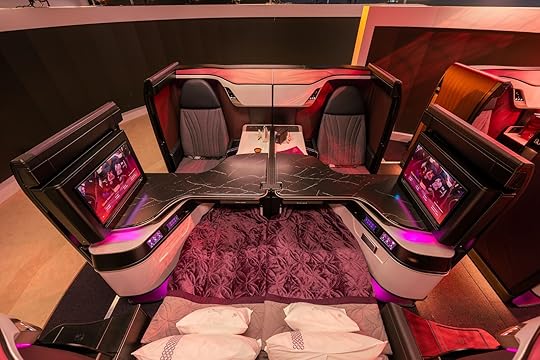
It’s no secret that Doha-based Qatar Airways is one of the best airlines in the world, as it consistently receives top awards from travelers in the US and beyond. And in London earlier this week, the airline unveiled yet another upgrade that will likely secure its reputation as a top airline — for travelers who can afford it, that is.
Qatar Airways plans to introduce new versions of its current business-class equivalent, called the “QSuites.” And if you thought the QSuites that launched in 2017 were comfortable, you’ll be shocked by how much more luxurious the airline is making them. “QSuite Next Gen” will be introduced on the airline’s new Boeing B777-9 planes by the end of 2025, though there’s no word on whether current planes will be retrofitted with the upgrades.
View this post on Instagram
A post shared by Qatar Airways (@qatarairways)
QSuites currently have sliding privacy doors, lie-flat beds, and bigger entertainment screens than those in economy class, among other draws. But the QSuite Next Gen will have features that are even more posh, including bigger suites, taller privacy doors, and extra storage space like draws and seat cubbies to keep in-flight items handy. Naturally, the suites are getting a high-tech revamp, too, with Qatar saying it plans to include wireless charging stations, swivel 4K TV screens, and additional USB-C high-speed charging ports.
But perhaps the most exciting features of the QSuite Next Gen is the flexibility it offers for couples or families traveling together. Families (or any group of four travelers) can book the reconfigured “Quad Suite” in the center of the new planes. It allows the privacy walls, tables, and TV screens to be rotated outward to make one large communal area, ideal for families that want to eat meals or watch a movie together at 30,000 feet.

The new Quad Seat will transform into one large space for four people, if wanted. Photo: Qatar Airways Group
Couples or other traveling duos can also merge their spaces in the QSuite Next Gen’s “Companion Suites.” They’ll offer the same benefits as the family suite, including the ability to combine the chairs into one larger lay-flat sleeping area.
QSuite guests will continue to have access to the same high-end amenities currently offered to any passengers within the class, including complimentary pajamas, high-end amenity kits, on-demand turn-down service, slippers, multi-course meals, and lounge access while in transit.
For now, if you’re content with flying the regular QSuites, expect to shell out. A single QSuite on a flight from Los Angeles to Doha this August (a 15.5-hour, non-stop route) will cost more than $10,000 one way. A standard economy seat on the same flight will cost $938 — plus an extra fee to select your seat, of course. 
This Airline Will Soon Offer Free Wi-Fi to All Its Passengers – Economy Travelers Included

Much like check-in luggage and seat selection, Wi-Fi is not an amenity that’s usually included in the price of your flight — you have to pay extra. Not only that but the more you want to use it, the higher the cost. From a few dollars for messaging to a good chunk of cash if you want unlimited usage. One international airline is about to put a stop to all of this expensive, sliding-scale nonsense, however: Turkish Airlines.
On July 22, 2024, Turkish Airlines announced that it would bring free and unlimited Wi-Fi to all its aircraft and offer it to all its passengers — even the ones in the back — by the end of 2025.
Stay connected at 30,000 feet! In partnership with TCI Aircraft Interiors and @Turksat we will bring free and unlimited Wi-Fi to our entire fleet by the end of 2025. We're integrating the latest in-flight connectivity tech to keep you online. @FIAFarnborough#FIA2024… pic.twitter.com/wbi6reBeuA
— Turkish Airlines (@TurkishAirlines) July 22, 2024
Currently, Turkish Airlines offers complimentary Wi-Fi to only select passengers and charges the rest of them $5 for unlimited messaging, $8 for 100 MB, $15 for 250 MB, $15 for unlimited internet on short-haul flights, and $35 for unlimited internet on long-haul flights.
With such an offer, Turkish Airline, already ranking as one of the top 10 airlines in the world year after year, will likely keep getting accolades.
Currently very few international airlines offer free Wi-Fi to all passengers. In the US, jetBlue is the only airline to do so, offering “free, high-speed wi-fi at every seat, on every plane.” 
Matador Network's Blog
- Matador Network's profile
- 6 followers



